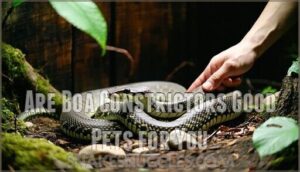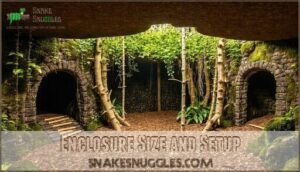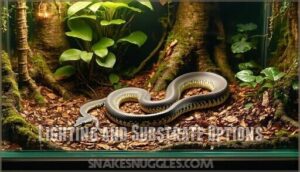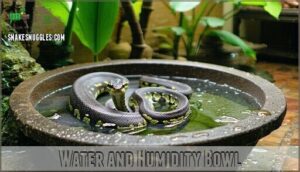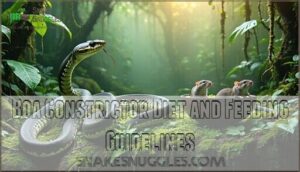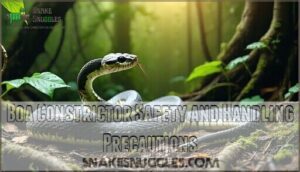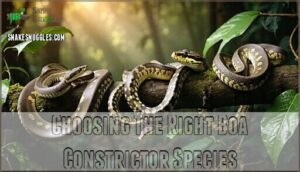This site is supported by our readers. We may earn a commission, at no cost to you, if you purchase through links.
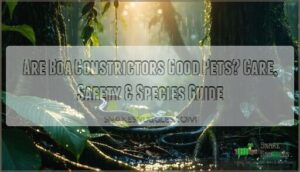
If you’ve ever wondered whether such a powerful creature can thrive as a pet, you’re not alone. The real question isn’t about danger, but about fit—yours and theirs. Knowing what life with a boa constrictor demands means understanding not just the animal, but the responsibility attached to keeping one healthy, safe, and secure.
Table Of Contents
- Key Takeaways
- Boa Constrictor Overview
- Are Boa Constrictors Good Pets for You
- Boa Constrictor Care and Housing Requirements
- Boa Constrictor Diet and Feeding Guidelines
- Boa Constrictor Health and Common Issues
- Boa Constrictor Safety and Handling Precautions
- Choosing The Right Boa Constrictor Species
- Frequently Asked Questions (FAQs)
- Are boa constrictors safe pets?
- Are boa constrictors dangerous?
- Are Boas good pets?
- Can a boa constrictor be housed with other snakes?
- What are common boa constrictors?
- Are boa constrictors legal?
- Are boa constrictors friendly?
- Do boa constrictors like to be held?
- Is a boa constrictor aggressive?
- Do boas like being handled?
- Conclusion
Key Takeaways
- Boa constrictors can be suitable pets for experienced keepers willing to commit 20-30 years, provide large enclosures (minimum 6x3x2 feet for adults), and maintain precise temperature gradients (85-90°F warm side, 75-80°F cool side) with 50-60% humidity.
- These snakes are generally docile and tolerant of handling when captive-bred and regularly socialized, but they don’t seek interaction like mammals and can display defensive behavior if threatened, stressed, or handled during shedding or digestion.
- Common health issues include respiratory infections from inadequate heating, scale rot from excessive moisture or poor hygiene, parasites like mites, and the untreatable inclusion body disease (IBD), making proper husbandry and quarantine protocols essential.
- Responsible ownership requires understanding local exotic pet laws, managing substantial ongoing costs for housing and feeding appropriately-sized frozen-thawed rodents, and recognizing that escape prevention and safe handling techniques are critical given their considerable strength and constriction ability.
Boa Constrictor Overview
Before you bring a boa constrictor into your home, you’ll want to understand what makes these snakes tick. Knowing where they come from, how big they get, and what to expect from their personality helps you decide if they’re the right fit for your lifestyle.
Here’s what you need to know about these impressive snakes.
Origin and Habitat
You’ll find boa constrictors across a sweeping range of terrain, from the dense rainforests of Central America to the dry savannas of Argentina. Their geographic range extends through Mexico, Central America, and much of South America, where wild populations occupy diverse native habitats.
The warm, humid climate of these tropical zones is exactly what boa constrictors need to thrive.
When you know what their wild habitat looks like, you can set up an enclosure that actually works for proper care.
While boa populations overall are doing fine, habitat loss is chipping away at certain areas—which makes keeping them right in captivity more important than ever.
Size and Lifespan
Before you commit to owning one of these impressive serpents, you need to know that boa constrictors reach substantial dimensions, often stretching 6 to 10 feet in length, with some individuals approaching 13 feet under ideal conditions. Growth rates vary considerably depending on feeding schedules and genetics, with baby boa constrictors growing rapidly during their first three years. Your adult boa constrictor will achieve maximum length by age five to seven, though weight factors continue to influence their bulk throughout their lives. Perhaps most important for reptile enthusiasts is understanding that these animals offer a long lifespan, with age expectancy reaching 20 to 30 years in captivity—a commitment spanning decades.
- Growth rates: Baby boa constrictors gain 12-18 inches annually during early years
- Maximum length: Most adults reach 7-9 feet, though genetics determine final size
- Average lifespan: Expect 25-30 years with proper husbandry and veterinary care
- Weight factors: Males usually weigh 10-15 pounds, females 20-30 pounds at maturity
Temperament and Behavior
While size and lifespan matter, your boa constrictor’s personality determines whether you’ll enjoy decades together or struggle with a defensive, unpredictable animal. Most boa constrictors display docile traits, remaining calm during routine contact when you respect their boundaries.
However, reptile behavior varies—stress signals like hissing, striking postures, or rapid tongue flicking warn you to back off. Their constriction methods activate defensively, not aggressively, when they feel threatened.
Snake socialization through consistent, gentle interaction helps establish predictable behavior patterns, though these solitary reptiles won’t bond like mammals do.
Handling and Interaction
Once you understand your boa’s personality, you’ll need to master the physical act of managing—supporting its weight, reading its body language, and knowing when to step back.
When handling your boa, focus on spreading support across several points of its body—think of it like cradling rather than gripping.
You want the weight distributed evenly while staying alert for stress signals: tightening muscles, sudden coils, or that telltale tensing up that says "I’m not comfortable.
Safe handling means catching those warning signs—muscle tension, sudden coiling, that unmistakable stiffening—before things go sideways and your boa shifts into defense mode with a constricting grip that’s tough to reverse.
Are Boa Constrictors Good Pets for You
How do you know if a boa constrictor fits your Pet Owner Lifestyle? Start by evaluating your commitment level and practical constraints. These snakes rank among the top ten most popular reptiles, appealing to reptile enthusiasts and beginners who understand boa constrictor care demands. You’ll need to assess several factors before deciding if they’re good pets for your situation.
- Space and longevity: Adult boas require enclosures at least 6 feet by 2 feet, and they live 20-30 years, demanding long-term commitment
- Pet Snake Laws: Check local regulations, as some jurisdictions require permits for snakes exceeding 8 feet or classify boas as high-risk species
- Boa Constrictor Cost: Initial setup and ongoing expenses for housing, heating, and feeding large prey items add up quickly
- Snake Behavior Patterns: Captive-bred boas are docile with regular interaction, though Central American varieties may hiss more than South American types
- Reptile Enthusiast Community: Connect with experienced keepers who can guide you through proper pet care practices
Approximately 2% of Americans own reptiles, with boas comprising a substantial share of the pet snake market. That’s why understanding your comfort level with feeding frozen rodents, potential salmonella exposure, and rare defensive bites matters before bringing one home. Boa constrictors are found across a wide range, from South America to northern Mexico.
Boa Constrictor Care and Housing Requirements
Creating the right environment for your boa constrictor isn’t just about picking a tank—it’s about replicating their natural habitat.
You’ll need to pay attention to several key factors, from the size of the enclosure to the temperature gradient inside.
Here’s what matters most for keeping your boa healthy and comfortable.
Enclosure Size and Setup
Think of your boa’s enclosure as more than just a container—it’s where they’ll spend their entire life, directly shaping how healthy and comfortable they are.
Adult boas need at least 6 feet by 3 feet by 2 feet, though going bigger gives them more to explore and interact with.
Your boa constrictor’s enclosure isn’t just a box—it’s the foundation of their health, behavior, and longevity, so getting the size and setup right from the start matters more than you might think. Adult boas need a minimum enclosure size of 6 feet by 3 feet by 2 feet, though larger dimensions provide better enrichment opportunities.
Your reptile enclosure should include multiple hiding spots—at least one on the warm end and one on the cool side—to help your snake feel secure. Climbing branches offer valuable vertical space, especially for younger boas. Substrate depth of 2-3 inches allows natural burrowing behavior while maintaining proper humidity levels.
Enclosure security is critical; boas are escape artists, so invest in secure locks. Add enrichment items like cork bark and sturdy branches to promote natural behaviors and reduce stress.
Temperature and Humidity Needs
Getting the thermal gradient and moisture levels right can mean the difference between a thriving boa and one that struggles with respiratory infections or poor sheds.
To keep humidity in check, you’ll need a few key tools:
Use these essential tools for effective humidity control:
- Ceramic heat emitters or under-tank heaters as primary heat sources
- Dual thermometers and hygrometers for accurate monitoring at both ends
- Large water bowls to provide ambient moisture
- Adequate ventilation systems to prevent stagnant air without drying the enclosure
Lighting and Substrate Options
Think of lighting and substrate as the foundation that determines whether your boa thrives or merely survives in captivity. Your boa doesn’t require UVB lighting like some reptiles, but a consistent 12-hour lighting cycle helps regulate natural behaviors.
Heat lamps create your temperature gradient, while substrate types—cypress mulch, coconut husk, or aspen shavings—directly impact humidity control and cleanliness. Choose substrates that hold moisture without becoming soggy, ensuring your boa constrictor care maintains proper humidity levels within the enclosure.
| Component | Recommendation |
|---|---|
| Lighting Cycles | 12 hours on, 12 hours off |
| Heat Sources | Ceramic emitters or heat lamps |
| Substrate Types | Cypress mulch, coconut husk, aspen |
| UV Lighting | Optional; not essential for boas |
Water and Humidity Bowl
A water bowl isn’t just a drinking station—it’s your boa’s personal humidity regulator and occasional spa, making it one of the most critical elements in the enclosure. You need a heavy, shallow bowl large enough for soaking, which aids shedding and humidity control. Position it away from direct heat to prevent rapid evaporation rates that destabilize humidity levels.
- Water quality: Change daily to prevent bacterial contamination affecting reptile health
- Bowl maintenance: Clean weekly with reptile-safe disinfectant for proper boa constrictor care
- Hydration systems: Monitor evaporation to maintain consistent humidity level in the enclosure
Boa Constrictor Diet and Feeding Guidelines
Here’s what you need to know about feeding schedules, prey sizes, and safe handling.
Let’s break down the key feeding guidelines you’ll need to follow.
Prey Size and Type
Stick with frozen-thawed rats or mice—they’re safer than live prey and far less likely to injure your snake during feeding.
Frozen-thawed rats or mice are ideal for prey selection, reducing injury risks associated with live feeding.
As your snake grows, adjust prey variation accordingly—juveniles take smaller meals, while adults manage larger rodents or even rabbits in their carnivorous diet.
Feeding Frequency and Schedule
Once you’ve nailed down the right prey type and portion, the next piece of the puzzle is timing—establishing a consistent feeding schedule keeps your boa’s metabolism steady and prevents both underfeeding and overfeeding complications.
Juveniles require meals every 5 to 7 days to support rapid growth, while adults thrive on feeding cycles of 1 to 2 weeks. Digestion rates slow as your boa matures, so meal planning adjusts accordingly.
During boa constrictor care, monitor your snake’s body condition; a well-fed boa maintains muscle tone without visible ribs or excessive fat. This carnivorous diet pattern ensures ideal snake nutrition and food intake balance throughout your boa constrictor’s life.
Feeding Techniques and Tips
How you present the meal matters just as much as what you serve, and getting the delivery method right can mean the difference between a confident strike and a feeding mishap. Always use feeding tools like tongs to deliver thawed prey—this protects your hands and reinforces natural strike responses.
Verify prey selection matches your boa constrictor’s girth, and maintain consistent feeding schedules to support proper nutrient balance. Remove uneaten food within 24 hours to prevent spoilage and stress during your snake feeding routine.
Supplements and Vitamins
Your boa’s diet delivers most of what it needs, but targeted supplementation can fill gaps that whole prey sometimes leaves behind. Rodents and rabbits naturally provide calcium and essential minerals, though captive conditions may create vitamin needs that require attention. Calcium deficiency can compromise bone health, particularly in growing snakes. Dietary enrichment through occasional mineral supplements bolsters nutrient balance and long-term reptile health.
- Dust prey with calcium powder every 4-6 feedings to prevent metabolic bone disease
- Monitor boa constrictor health for signs like lethargy or poor appetite indicating deficiencies
- Avoid over-supplementation, which can harm your snake as much as deficiencies
- Consult a reptile veterinarian for customized boa constrictor feeding recommendations
Boa Constrictor Health and Common Issues
Spotting early warning signs means you can step in before small problems turn into big ones. Here are the most common health issues boa owners encounter.
Recognizing early warning signs helps you catch issues before they become serious. Let’s look at the most common health concerns you’ll need to watch for in your boa.
Respiratory Infections
Lower respiratory tract disease affects a significant proportion of captive boas, making respiratory infections one of the most concerning snake health issues you’ll face. You’ll notice breathing issues like wheezing, nasal discharge, or open-mouth breathing when your boa develops snake pneumonia.
These respiratory symptoms often stem from inadequately heated enclosures, where cool temperatures compromise your snake’s immune function and create conditions for bacterial or fungal infections. Tracheal problems can progress rapidly if ignored, sometimes resulting in fatal outcomes.
Infection control starts with maintaining proper temperatures and humidity in your boa constrictor care routine, but prompt veterinary intervention with appropriate antibiotics is essential when respiratory infections develop. Regular monitoring of your boa constrictor health helps catch these problems early, before they become life-threatening. Understanding reptile health issues is vital for providing the best care for your pet boa constrictor.
Parasites and Mites
When it comes to parasite control, staying alert makes all the difference in keeping your boa constrictor healthy. Mite infestations and ticks drain your snake’s energy and open the door to infections that can seriously compromise their health.
Protect your boa by:
Vigilance is your best tool regarding parasite control in boa constrictor care. Mite infestations and ticks can sap your pet’s vitality, introducing infection risks that complicate reptile health. Here’s how to protect your boa:
- Spot early warning signs of snake acariosis and irritation.
- Routinely clean enclosures for ideal Boa constrictor health.
- Prioritize tick prevention to minimize dangerous snake health issues and maintain long-term well-being.
Scale Rot and Skin Infections
Prevention is the foundation of reptile health, especially regarding scale rot and skin infections in boas. Keeping humidity within 55–75% and offering a spotless habitat will reduce most risks. Common irritants like mite infestations, damp bedding, or dirty cages lead to weakened scales and open doors to infection. Watch for blisters or discoloration as signals of trouble.
| Scale Rot Causes | Dermatitis Prevention | Skin Infection Treatment |
|---|---|---|
| Damp Substrate | Daily Spot Cleaning | Antibacterial Topicals |
| Mite Infestations | Humidity Control | Veterinary Intervention |
| Filthy Enclosure | Routine Checks | Clean, Dry Environment |
| Poor Ventilation | Shedding Support | Fungal/Bacterial Remedies |
| Sharp Cage Items | Gentle Care | Remove Irritants, Monitor Healing |
Inclusion Body Disease
Uncertainty shadows boa constrictor care when inclusion body disease (IBD) enters the picture. This untreatable viral disease quietly undermines boa health, often spreading through mites or direct snake-to-snake contact.
Spotting IBD symptoms isn’t always straightforward—head tilting, loss of coordination, or sudden regurgitation may be clues, but some boas show no outward signs.
Regular virus research and prompt testing protect your reptile health. In IBD cases, prevention outshines cure; quarantine and strict hygiene are essential for boa constrictor wellbeing.
Boa Constrictor Safety and Handling Precautions
Before you reach in, there are a few things worth knowing.
Here’s what matters as you weigh your choices.
Here’s what to keep in mind as you go through your options.
Constriction Hazards and Risks
Ever wondered how a snake’s gentle hold can suddenly turn into a full-body vise? Boa constrictors can surprise with impressive constriction power, so respecting their strength is vital. To reduce constriction risks and protect pet safety, remember these essentials:
- Recognize signs of agitation.
- Monitor children and pets closely.
- Secure enclosures.
- Prevent snake escapes.
- Learn snake bite prevention.
Handling Techniques and Safety
Think of managing a boa constrictor like guiding a river—gentle direction and respect are what keep you both safe. Use a snake hook first, then offer calm, steady hands for support. Never grab suddenly; smooth movements reduce constriction risks. Avoid managing after feeding. Prioritize safety precautions, snake bite prevention, and proper response with each interaction.
| Safe Managing | What to Avoid |
|---|---|
| Use gentle support | Sudden grabbing |
| Steady movements | Managing after meals |
| Snake hook assists | Ignoring signs |
| Plan emergency response | Overconfidence |
Signs of Stress and Aggression
Every boa has a way of saying “enough”—sometimes it’s louder than words. Watch for classic boa constrictor behavior: a tight coil, hissing, or rapid tongue flicks signal stress signals or aggression triggers. Ignore these, and you risk a strong threat response. Reading body language is key:
- Hissing loudly
- Thrashing violently
- Striking defensively
- Tightly wrapping around objects
Emergency Procedures and First Aid
When things go sideways with a boa constrictor, knowing what to do next is just as important as catching the early warning signs. Be ready to manage health issues and animal welfare challenges:
- Keep a First Aid Kit for Snake Bites and Constriction Injuries
- Have your veterinarian’s info posted
- Store safe management tools
- Act promptly in emergencies
- Monitor for venomous exposure
Choosing The Right Boa Constrictor Species
Choosing a boa constrictor means thinking about more than just their size or look. Each species has its own quirks and care needs that can make a real difference in your experience.
Let’s break down the most popular options.
Here’s what you should know about the most popular options.
Common Boa Constrictor
Adaptability defines the Common Boa Constrictor—a species thriving in forests, swamps, and home enclosures alike.
This boa’s mixture of striking patterns and straightforward snake behavior fits well with responsible pet ownership. Their generally manageable temperament and predictable Boa morphs invite both newcomers and experienced reptile enthusiasts to experience the unique rewards of constrictor care and long-term Boa constrictor ownership.
Red-Tailed Boa Constrictor
Redtail boas stand out with vivid red saddle patterns and a commanding presence, rewarding careful pet ownership and attentive Red Tail Care. These larger boas test your skills but spark curiosity in any reptile enthusiast. For experienced keepers, they offer:
- Impressive size
- Stunning Boa morphs
- Demanding Snake habitat needs
- Responsive constrictor behavior
Commitment is key with these giants.
Rosy Boa Constrictor
Compared to their larger cousins, Rosy Boa Constrictors are easier to manage for new keepers or families wanting a gentle introduction to pet snake behavior. Their modest size, simple Rosy Boa Habitat needs, and varied Boa morphs make them approachable.
Consistent constrictor care and attention to detail nurture a thriving companion—perfect for anyone passionate about Boa constrictor species or reptile conservation.
Kenyan Sand Boa Constrictor
The Kenyan Sand Boa stays refreshingly small—a real plus for newcomers wanting manageable Boa constrictor care.
These gentle burrowers don’t ask for much: straightforward Sand Boa Habitats and consistent feeding routines. What makes them beginner-friendly?
Small size sets the Kenyan Sand Boa apart. For the beginner keen on manageable Boa constrictor care, these gentle burrowers are an ideal choice. They favor simple Sand Boa Habitats and steady Boa Constrictor Diet schedules. Here’s what to expect:
- Rarely exceed 3 feet.
- Placid, forgiving temperament.
- Low-humidity needs.
- Easy Kenyan Boa Breeding for hobbyists.
Amazon Tree Boa Constrictor
Striking coloration and exceptional agility set the Amazon Tree Boa apart—a species for reptile enthusiasts who appreciate challenge and beauty in equal measure.
Thriving with proper Arboreal Care, these slender climbers require Vertical Enclosures that mimic their natural Tree Boa Habitat, high up and humid. While their vivid patterns dazzle, unpredictable Constrictor Behavior means they aren’t ideal for inexperienced keepers.
Their Amazonian Diet centers on birds and rodents, demanding steady husbandry. For those invested in expert Boa constrictor care, Amazon Tree Boas reward attentive ownership with endless fascination.
| Requirement | Amazon Tree Boa |
|---|---|
| Size | 5–6 feet (adult) |
| Lifespan | 15–20 years |
| Habitat Type | Arboreal, vertical setup |
| Temperament | Active, unpredictable |
Frequently Asked Questions (FAQs)
Are boa constrictors safe pets?
Boa constrictors are safe pets for experienced keepers who understand constrictor behavior and reptile management. Their docile nature reduces snake attack risks, but proper enclosure and safe management are essential to prevent accidents.
Additionally, compliance with exotic pet law requirements is crucial for responsible ownership.
Are boa constrictors dangerous?
Like a gentle river that can suddenly surge, boa constrictors aren’t usually aggressive, but can defend themselves if startled or mishandled.
While Constrictor Attacks are rare, practical Boa constrictor care reduces Pet Risks and Snake Bites.
Are Boas good pets?
Proper boa constrictor ownership calls for serious commitment and planning, from understanding snake behavior and boa constrictor costs to following reptile laws and selecting pet insurance options.
Their unique needs make boa constrictor care demanding, but rewarding for responsible pet owners.
Can a boa constrictor be housed with other snakes?
Picture solitary mountain peaks—boa constrictors reflect this spirit. Snake compatibility is poor; housing options should favor lone enclosures.
Multi-species enclosures risk constrictor behavior issues, stress, and aggression, making snake socialization unsafe for responsible snake ownership.
What are common boa constrictors?
Common boa constrictors, known scientifically as Boa constrictor imperator, are favored among Pet Boas for their moderate size and gentle disposition.
This Boa Species displays diverse Snake Morphs, making them a top choice for Boa constrictor ownership.
Are boa constrictors legal?
Regarding boa constrictor ownership, it’s wise to look before you leap. Exotic pet laws and snake regulations can shift with the tide—always check with local authorities about animal permits, legal ownership, and wildlife conservation rules.
Are boa constrictors friendly?
Most boa constrictors display a gentle, docile snake temperament when handled regularly from a young age. Their pet friendliness improves through consistent reptile socialization, though they won’t bond like mammals.
Understanding boa behavior and constrictor safety helps you read their body language and prevent defensive responses during interaction with owners.
Do boa constrictors like to be held?
There’s an old saying: actions speak louder than words, and with boas, their body language tells you everything. Unlike puppies, your boa constrictor won’t seek out touching, but regular, gentle interaction builds tolerance and calmness.
These snakes manage well when they’re relaxed—avoid holding during shedding or digestion. With proper snake management techniques and attention to boa constrictor temperament, you’ll recognize when your snake’s comfortable, making each interaction safer and more predictable.
Is a boa constrictor aggressive?
Most boa constrictors are docile snakes with calm temperaments, rarely showing aggression toward humans. However, defensive behavior can emerge if they feel threatened, stressed, or improperly managed.
Factors like age, individual personality, and care practices greatly influence snake behavior. Young boas may display more defensive postures initially, but regular, gentle management helps them acclimate to human interaction.
Watch for aggression signs like hissing, striking, or coiling tightly—these indicate stress. Understanding snake temperament and maintaining proper care minimizes constriction risks and prevents defensive responses, making boa constrictors manageable companions for informed keepers.
Do boas like being handled?
While boa constrictors tolerate being held, they don’t seek it out the way mammals do. Regular, gentle interaction helps maintain their docile snake temperament.
Avoid holding them during shedding or post-feeding periods, when constriction methods may be triggered by stress or defensive boa behavior.
Conclusion
Before the telegraph, news traveled slowly—but decisions about keeping boas should never be rushed. Are boa constrictors good pets? Only if you’re prepared for decades of commitment, specialized care, and the reality that these animals demand space, patience, and respect.
They’re not starter reptiles or impulse buys. But for keepers who understand their needs and take responsibility seriously, boas offer something rare: a long-term partnership with one of nature’s most extraordinary predators, built on trust rather than illusion.
Boas aren’t for beginners, but for committed keepers, they offer a rare partnership with nature’s predators built on trust, not illusion
- https://www.reddit.com/r/BoaConstrictors/comments/13anz0r/how_many_people_have_a_boa_constrictor/
- https://www.wiseguyreports.com/reports/pet-snakes-market
- https://reptifiles.com/boa-constrictor-care/buy-boa-constrictor-guide/
- https://obamawhitehouse.archives.gov/sites/default/files/omb/assets/oira_1018/1018_04182011-3.pdf
- https://www.petmd.com/reptile/boa-constrictor-care-sheet

